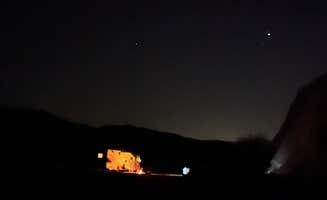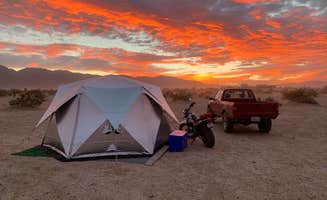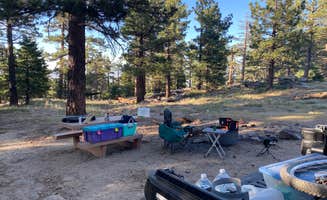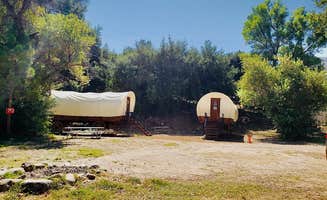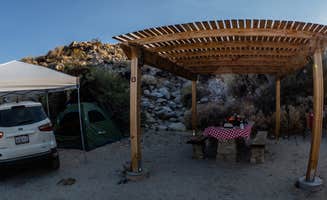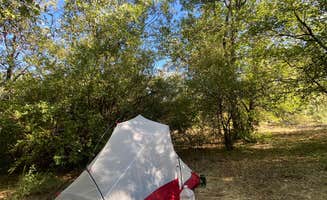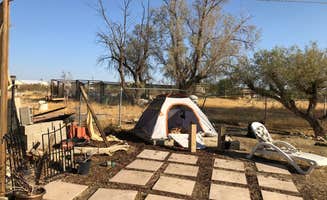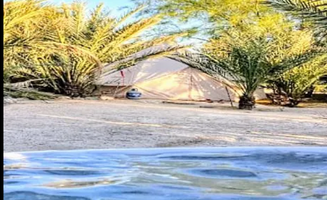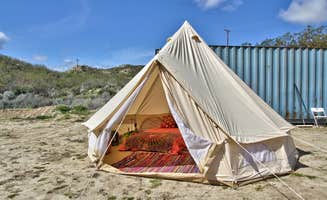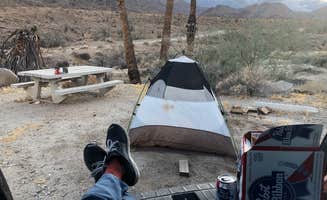Desert camping areas near Coolidge Springs, California span nearly 600,000 acres of public land with elevations ranging from 500 to 1,500 feet above sea level. The region features a Sonoran Desert ecosystem dominated by creosote bush, ocotillo, and various cacti species. Winter temperatures typically range from 40-70°F while summer temperatures frequently exceed 110°F in the shade.
What to do
Canyon hiking and exploration: Box Canyon Dispersed offers unique geological formations with eroded cliff walls. Kenny W. notes, "Shear cliffs that are heavily eroded. Very distinct layers of floods. Nice hikes up thin canyons." The canyon area provides opportunities for photography and geology enthusiasts.
Stargazing at night: The minimal light pollution and clear desert air create exceptional stargazing conditions. At Ocotillo Wells State Vehicular Recreation Area, Geoff H. recommends planning ahead: "Do your research before you head out there so you know what you want to see. Great area though to bring anyone and everyone to enjoy the night sky and see some desert beauty."
Wildlife observation: Early mornings provide opportunities to spot desert wildlife including jackrabbits, roadrunners, and various reptiles. At Bow Willow Primitive Campground, Stephen B. suggests taking "a nice hike to a palm grove" where wildlife often congregates near water sources.
What campers like
Natural isolation: At Pine Creek Road Camp, campers enjoy the seclusion. David notes, "A great spot if you want to get away and enjoy some alone time... we never saw another person during our stay." Most dispersed camping areas near Coolidge Springs offer similar privacy during weekdays.
Desert landscape diversity: The changing desert colors throughout the day attract photographers. Ralitsa K. explains her experience at Bow Willow: "This campsite was first come first serve. We set up quickly and enjoyed ourselves a walk around the site. Not too many trailheads around and it was very hot and dry but we enjoyed it."
Clear access to trails: Many campsites connect directly to hiking paths. At Tool Box Springs Yellow Post Campground, Kyle M. mentions, "The Romona trail starts/ends directly behind the washhouse," making it convenient for morning or evening hikes when temperatures are cooler.
What you should know
Vehicle requirements: Many camping areas require high-clearance or 4WD vehicles. Jake P. warns about Tool Box Springs: "Without a high clearance vehicle, it took me an hour and a half to go six miles up, and still scraped and almost got stuck. Definitely would say need a high clearance vehicle for some of the ruts."
Temperature extremes: Desert temperature fluctuations require proper preparation. Kris K. from Ocotillo Wells advises: "Avoid big weekends and pack 3 times the amount of water that you think you would need." Summer camping is particularly challenging with temperatures often exceeding 110°F.
Insect considerations: Depending on season, insects can impact camping comfort. Steve H. reports about Tool Box Springs: "This site would've been perfect, and I mean perfect, but the flies were unbearable. I planned to stay two nights but I couldn't make it past the next morning. If I stood still even for a second I was swarmed."
Permit requirements: Some areas require free permits. For Yaqui Wash, a wilderness permit is recommended but not strictly enforced during off-peak periods. For Pine Creek, one camper notes: "Make sure you apply for the free permit a few days in advance especially if you plan to go on the weekend."
Tips for camping with families
Site selection for tent camping: When tent camping near Coolidge Springs with children, select areas with natural barriers from vehicle traffic. Abe C. describes Yaqui Wash: "The parking spots are right alongside the road, so for van camping is not so great, but tents can be put away from the road and therefore it's much more suitable for tenting."
Water conservation strategies: Each person needs at least 2 gallons of water per day. No reliable water sources exist at most dispersed sites. As Timothy A. notes about Ocotillo Wells: "Great place to go get off grid if you don't mind off-road vehicles. Plenty of open space to get away from the crowds."
Weekend vs. weekday planning: Families often prefer weekday camping for quieter experiences. Nick A. from Box Canyon Dispersed reports: "We had a great time. The kids did some exploring. Found a Geocache… we had two foxes come and visit the campsite."
Tips from RVers
Road access evaluation: RVers should carefully assess road conditions before attempting desert camping. Jennifer D. provides useful insight about Ocotillo Wells: "I've mostly RV camped here during the annual Jeep event in March/April. We get there early to get a prime uncrowded spot for our caravan. Obviously no RV hookups and no shade as it's the desert. FWD isn't required, I made it with my 4cyl Toyota RAV4."
Leveling preparations: Most desert camping areas have uneven terrain requiring leveling blocks. Nick A. recommends Box Canyon for "RV Dry Camp" noting the desert terrain requires preparation for a level setup.
Generator considerations: While generators are technically allowed at most dispersed sites, campers report noise complaints about excessive generator use. For better etiquette, limit generator use to 1-2 hours in morning and evening.


